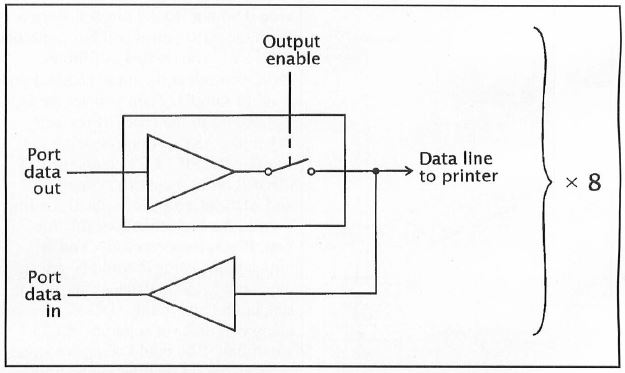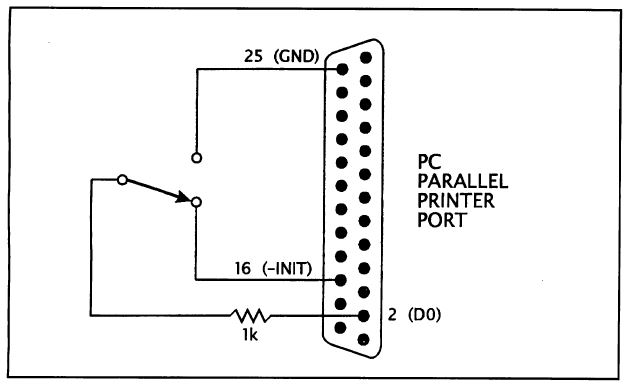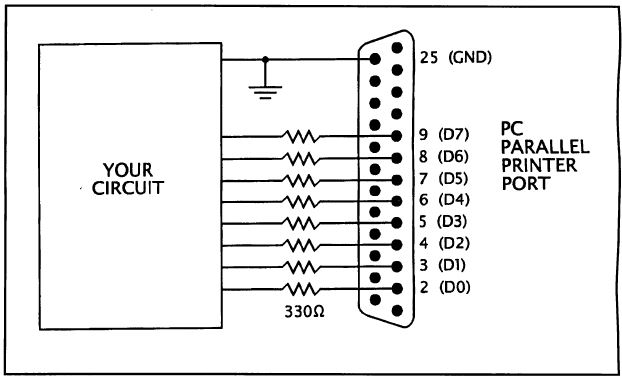|
Author: Michael A. Covington
Source: MicroComputer Journal, Nov/Dec 1995 (pages 34-37 physical)
Note: In an effort to better understand the PS/2
Bidirectional parallel ports, I have searched for period articles describing
them. In this case, I am not sure if and why the author thinks the Model 50
port can't be set to Bidirectional. This article seems to reference the "Type
1" parallel port. YMMD, -LFO
Many newer PCs, especially laptops, have bidirectional parallel printer
ports that can read as well as write the eight data lines. As a result, the
parallel printer port can be used like the bus of an eight-bit microprocessor
to send data in both directions, and it interfaces nicely with numerous
eight-bit devices. Jan Axelson's recent articles in Microcomputer Journal have
explored in detail how to use the standard features that all parallel printer
ports have in common. In this article, I'll tell you how to exploit
bidirectional data lines if you have them.
To avoid misunderstanding, keep in mind that you can transmit data
bidirectionally without using a bidirectional parallel port, as long as you do
your input somewhere other than the eight data lines. Thus, for example, Eddie
McMullen's printer-port voltmeter (MCJ, March/April 1994) doesn't require a
bidirectional parallel port. "Bidirectional" means that the data lines, not
just the status and control signals, are capable of input.
Data-Line Input
To take input through the data lines of the parallel port, you have to do
three things: enable bidirectionality, switch the port into read mode and read
the data.
Enabling bidirectionality is the difficult part. Bidirectional ports aren't
bidirectional unless you explicitly set them up to be. This is to keep older
software from accidentally putting the port into read mode by mistake. To make
the parallel port bidirectional, you set a jumper (on most newer multifunction
I/O cards) or run a setup program (on Toshiba and Zenith laptops, among
others).
'PS2BIDIR.BAS - M. Covington 1994
'For IBM PS/2 Models 50 and up.
'Uses Programmable Option Select (PCS) to
'make motherboard parallel port bidirectional.
'Effect lasts until next reboot.
DEFINT A-Z
OUT &H94, INP(&H94) AND &H7F 'unlock POS
OUT &H102, INP(&H102) AND &H7F 'clear bit
OUT &H94, INP(&H94) OR &H80 'lock it back
PRINT "PARALLEL_1 (LPT1) is now bidirectional."
END
Listing 1: QBASIC Program to Enable PS/2 Bidirectional Parallel Port
On an IBM PS/2 (Model 50 or greater), the only way to enable
bidirectionality on the built-in parallel port is to run the special
PS2BIDIR.BAS program given in Listing 1. This program uses the PS/2's
Programmable Option Select (POS) facility to make the parallel port
bidirectional. Its effect lasts until you re-boot your computer. With
after-market PS/2 parallel ports, you have it easier because you can generally
select bidirectional mode in the setup program on the Reference Diskette.
With bidirectionality enabled, the port is still an output device and still
drives a printer in the usual way until you switch it into read mode by setting
Bit 5 or 7 in the control register. There's no harm in setting both bits.
Some computers use one and some use the other. In BASIC, the
instruction to do this is:
OUT control, INP(control) OR &HA0
where control is the address of the control register (the parallel port base
address plus 2). For example, if the port is at hex 0378, control will be hex
037A. To get back into write mode, key in:
OUT control, INP(control) AND &H5F
Implementing Bidirectionality

Fig. 1. All PC printer ports can read back their own output.
Bidirectional ones can disconnect the output driver to accept Input.
Illustrated in Fig. 1 is how bidirectionality is implemented. All parallel
printer ports have the ability to read back the data that's output to them. The
original IBM PC used this feature for testing. The only thing new in a
bidirectional port is the ability to disconnect the output from the data line,
while the read-back inputs remain connected. You can read these TTL compatible
inputs by taking input from the base address of the parallel port as
follows:
result = INP(addr)
where addr is hex 037C, 0378, or 0278, as the case may be. The data bits
aren't inverted. Each is 0 if low and 1 if high. Disconnected pins usually read
as 1 but may pick up random noise if your parallel port uses CMOS or NMOS
technology.
If the port is still in write mode and you try to read it, you'll get back
whatever data was last written to it. You can exploit this fact to test whether
a printer port is really bidirectional by writing a distinctive bit pattern to
it (not 11111111 or 00000000, which might correspond to disconnected pins),
switch the port to read mode (or try to) and see if you get the same bit
pattern when you read it. If you do, the port is almost certainly not
bidirectional, or at least isn't really in read mode.
'PPORT.BAS - M. Covington 1994
'Displays all bits of PC or PS/2 printer port
DEFINT A-Z
top:
CLS
INPUT "Which LPT port? (1. 2, 3, or 4) ", N
N = (N - 1) * 2 + 8
'Get port address
DEF SEG = &H40
addr = PEEK(N) + 256 * PEEK(N + 1)
status = addr + 1
control = addr + 2
IF addr = 0 THEN
PRINT "No such port." : BEEP : GOTO top
END IF
'Output 01010101. If same pattern Is read back in,
'port is probably not bidirectional.
OUT addr, &H55
'Set direction bit to READ
OUT control, (INP(control) OR &HA0)
'To undo this: OUT control, (INP(control) AND &H5F)
'Display parallel port bits over and over
PRINT "Press Ctrl-Break to exit."
DO
LOCATE 5, 1
PRINT "Control bits at", HEX$(control), BIN$(INP(control))
PRINT "Status bits at", HEX$(status), BIN$(INP(status))
PRINT "Data bits at", HEX$(addr), BIN$(INP(addr))
LOOP
END
FUNCTION BIN$ (i)
'Like HEX$, but binary.
j = 128
s$ = ""
WHILE j > 0
IF (i AND j) <> 0 THEN
s$ = s$ + "1"
ELSE
s$ = s$ + "0"
END IF
j = j / 2
WEND
BIN$ = s$
END FUNCTION
Listing 2. Program Display All Parallel Printer-Port Bits
Which LPT port? (1, 2, 3, or 4) 1
Press Ctrl-Break to exit.
Control bits at 3BE 11001100
Status bits at 3BD 01111111
Data bits at 3BC 11111111
Fig. 2. Output of PPORT.BAS is this continuously updated display
PPORT.BAS Listing 2 is a program that puts all this together. Figure 2 shows
how it displays all the bits of all three parallel-port registers. To
demonstrate that a port is bidirectional, use the circuit in Fig. 3. The lowest
data bit should toggle back and forth as you flip the switch. The 1,000-ohm
resistor protects the parallel port against shorted outputs in case it turns
out not to be in read mode when you perform the test.

Fig 3. Simple demonstration of input through a parallel-port
data line. -INIT line is normally high (+5 volts).
'ADC0803.BAS - M. Covington 1994
'Interfacing an analog-to-digltal converter
'through a bidirectional parallel port
DEFINT A-Z
CLS
'Assume it's LPT1; see PPORT.BAS
N = 8
'Get port address
DEF SEG = &H40
addr = PEEK(N) + 256 * PEEK(N + 1)
control = addr + 2
'Set direction bit to READ
OUT control, (INP(control) OR &HA0)
'Initialize ADC by taking STROBE low, then high
OUT control, (INP(control) OR 1)
OUT control, (INP(control) AND &HFE)
'Display data over and over
PRINT "Press Ctrl-Break to exit."
DO
LOCATE 5, 1
PRINT INP(addr); " "
LOOP
END
Listing 3. Program to Read Data From Analog-to-Digital Converter
Figure 4 shows how to approach interfacing. Protective resistors are
required because the parallel printer port is an output device from the moment
your computer boots up until you put it into read mode, yet is connected to the
outputs of your external equipment. Shorting outputs to each other can easily
damage logic ICs unless current is limited to a safe level.

Fig. 4. General scheme for interfacing to bidirectional
parallel port. Resistors protect ICs when both devices are in output mode.
The 330-ohm resistors pass TTL level signals transparently but limit current
to 10 mA when a low output gets shorted to a high output, or vice versa. This
is a good use for the 330-ohm resistor packs that once were used as terminators
on diskette drives. If your parallel port has MOS inputs (most bidirectional
ones do) and you're using the data lines for only input, not output, you can
usually get away with much larger-value resistors for added safety.
Interfacing
Shown in Fig. 5 is a practical interfacing setup. An ADC0803
analog-to-digital (A/D) converter reads its input voltage (0 to +5 volts) as a
value from 0 to 255. ADC0803.BAS Listing 4 is a program that accepts the input
and displays it. The eight data lines carry the data, through 330-ohm
protective resistors. The strobe line is used to reset the ADC so that it will
start running at the beginning of a session. No protective resistor is needed
because, unlike the data lines, the strobe line isn't a TTL totem-pole output.
It's open-collector, with a 4,700-ohm pull-up resistor, and can't drive
excessive current into the ADC.
 Fig. 5. Designed for eight-bit microprocessor bus, ADC0803A/D
converter interfaces equally well to bidirectional parallel port. ADC0801,
0802, 0804, and 0805 work in this circuit. Potentiometer varies input voltage
for testing purposes
Fig. 5. Designed for eight-bit microprocessor bus, ADC0803A/D
converter interfaces equally well to bidirectional parallel port. ADC0801,
0802, 0804, and 0805 work in this circuit. Potentiometer varies input voltage
for testing purposes
Finally, a word about "brute-force bidirectionality." Some experimenters
have found that a standard (unidirectional) PC parallel port can work
bidirectionally if driven by a circuit that can sink a lot of current (like 20
mA) in the low state. The technique is to write all 1s to the base address of
the port and then pull some of the data lines low and read the data back in.
Sure enough, the lines that are pulled low read back in as 0, not 1. But this
technique risks overheating the output chip (originally a 74LS374, nowadays
often a special NMOS or CMOS LSI circuit). (Note: A
XIRCOM patent
mentions this "forcing" with use of the Pocket adapters on older IBM PCs, maybe
early PS/2s. -LFO)
A better technique, if you have an original IBM parallel port or close
equivalent, is to find Bit 5 of the control register (it's decoded at the
output of a 74LS174 but never used) and route it to the output-enable pin of
the 74LS374 that drives the data lines. This will require a bit of circuit
tracing and shouldn't be done blindly.
The alternative is to just buy an I/O card that includes a new-style
bidirectional parallel port. Be wary of connecting experimental circuits to
your main I/O card if it includes disk controllers and other vital parts of
your PC. Such ports are very vulnerable to static damage, and when zapped, they
crash the whole computer.
|